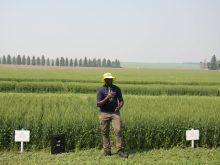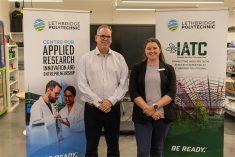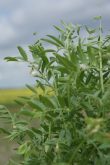Flax thrives when planted after wheat | The secret lies with beneficial fungi that flourish in wheat fields and boost uptake
About 10 years ago, Marcia Monreal, an Agriculture Canada scientist at the Brandon Research Centre, was part of a field experiment that demonstrated how flax yields are influenced by crop sequence. Monreal and her Ag Canada colleagues found that flax yields are significantly higher if the preceding crop is wheat and lower if the previous crop is canola.
Although the results of that study, published in the Canadian Journal of Plant Science, were intriguing, it ended with a typical conclusion for an academic paper: more investigation is needed to understand this phenomenon.
Read Also

Fertilizer method’s link to emissions studied
A researcher says others studying greenhouse gas emissions aren’t considering how the loss of nitrogen into the atmosphere correlates with fertilizer application or if there is an impact to yield.
Now, a decade or so later, Monreal, a soil microbiology specialist with Agriculture Canada, may know now why flax yields are dependent on crop sequence and she is conducting a field study near Brandon this summer to prove her hypothesis.
In her office at the Brandon Research Centre, Monreal drew graphs and pictures on a whiteboard as she talked, to explain why the preceding crop affects flax yield.
Put simply, flax roots respond differently to phosphorus fertilizer than most other field crops.
In fact, for many years, soil fertility experts were perplexed by flax’s lack of response to phosphorus.
“When they (researchers) applied phosphorus they wouldn’t see a difference between the one (plot) that had high phosphorus to the one that had no phosphorus,” Monreal said. “The yield would not change. That’s very puzzling for people in soil fertility.”
Cindy Grant, Monreal’s colleague in Brandon and a soil fertility expert, wrote the paper on flax and crop sequence. In the same study, she also looked at phosphorus’s impact on flax growth and yield.
She concluded that phosphorus fertilization had essentially no impact on early season biomass production or flax yield.
But the experimental plots where flax was planted after wheat consistently yielded more than flax after canola.
At one site in the experiment, for example, the yield following canola was 25 bushels per acre. After wheat it was nearly 30 bu. per acre.
Subsequent studies have supported Grant’s conclusion that crop sequence has a significant influence on flax yield.
“They (scientists) were doing canola cultivar trials in a farmer’s field and it was in the middle of another field that had wheat,” Grant said. “The next year he (the producer) seeded flax. The farmer was very irate because there were these big blocks, wherever the canola had been, where the flax was terrible.”
Drawing a flax root on her whiteboard, to explain why flax doesn’t respond to phosphorus fertilizer, Monreal said most crops directly tap into phosphorus fertilizer molecules in the soil. But flax roots actually grow around the phosphorus particles in the soil, avoiding the source of nutrition, Monreal said.
To get phosphorus out of the soil, flax needs a community of helpful mycorrhiza fungi on its roots. As Monreal noted in a summary paper, the mycorrhiza forms tree-like structures inside the cells of the plant’s roots.
Pointing to an image of a flax root, Monreal showed how a fungus filament grows out of the root, which transports nutrients and water back to the plant.
“This is the one that makes the connection to get minerals inside the plant. It’s like an intravenous,” she explained, gesturing at an image of a tiny, hair-like structure, protruding from the plant’s root.
So, flax plants need mycorrhiza fungi in the soil to access nutrients underground. Which explains why flax yield improves after wheat, because the cereal is one of many field crops that grows in synergy with mycorrhiza. Canola isn’t a mycorrhiza host so flax roots don’t have an established community of fungi, if it’s planted following a canola crop.
To prove there’s a link between flax yield and mycorrhiza populations in the soil, Monreal grew flax in a growth chamber at the Brandon Research Centre. Inoculants with mycorrhizal fungi were added to certain flax plants and other plants didn’t receive an inoculant.
Yet, after examining the plants, Monreal came to a conclusion that runs counter to common sense. The flax plants without the fungi produced more capsules. Yet, the capsules weighed 40 percent less than the inoculated plants, meaning the inoculated plants were fuller.
“This difference was significant,” she said, adding the capsules of inoculated plants weighed 5.5 grams, while the capsules in the control group weighed 3.5 grams.
This would suggest that more flowers and more capsules don’t always equal more yield.
“When you see a field full of flowers of flax and you see (all) the capsules, you think you’re going to have a good yield. But that might not be the case,” she said.
To verify her laboratory results, Monreal is conducting field trials this summer at an organic farm near Brandon, where she has treated flax plants with a variety of mycorrhizal inoculants. When the plots are harvested, she will know if the fungi do boost flax yields under field conditions.
If the lab results hold up, this doesn’t mean flax growers should run out to buy mycorrhizal inoculant, Monreal said.
Yet, if flax growers can get their crop sequence right and properly manage the mycorrhiza population in the soil, there may be the potential to save money on fertilizer.


















